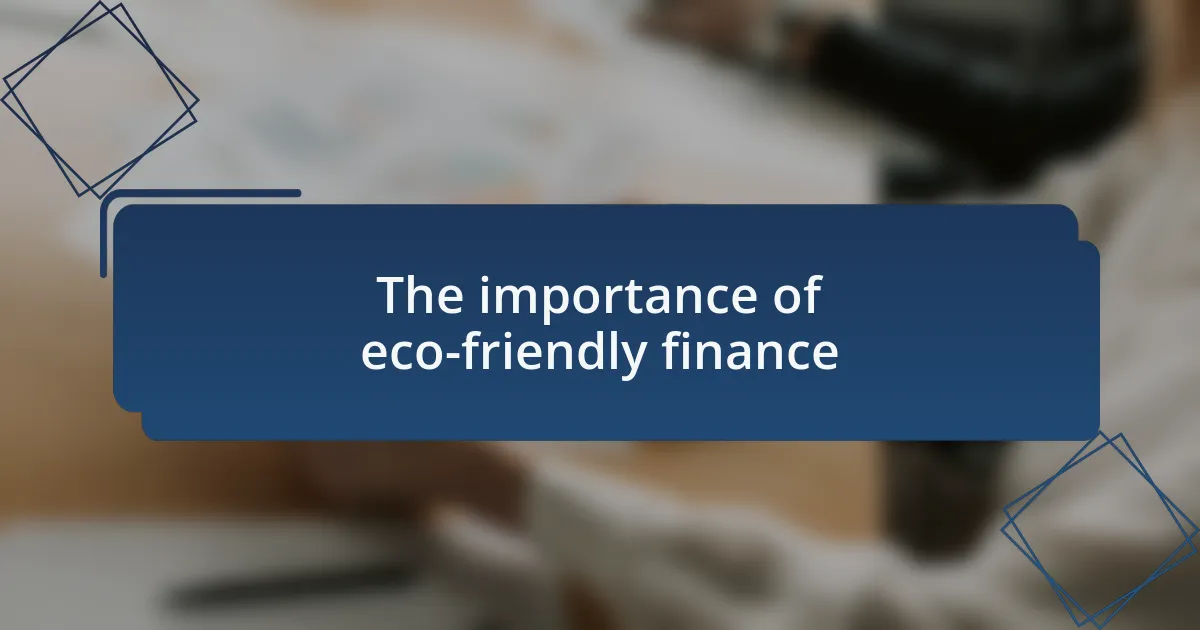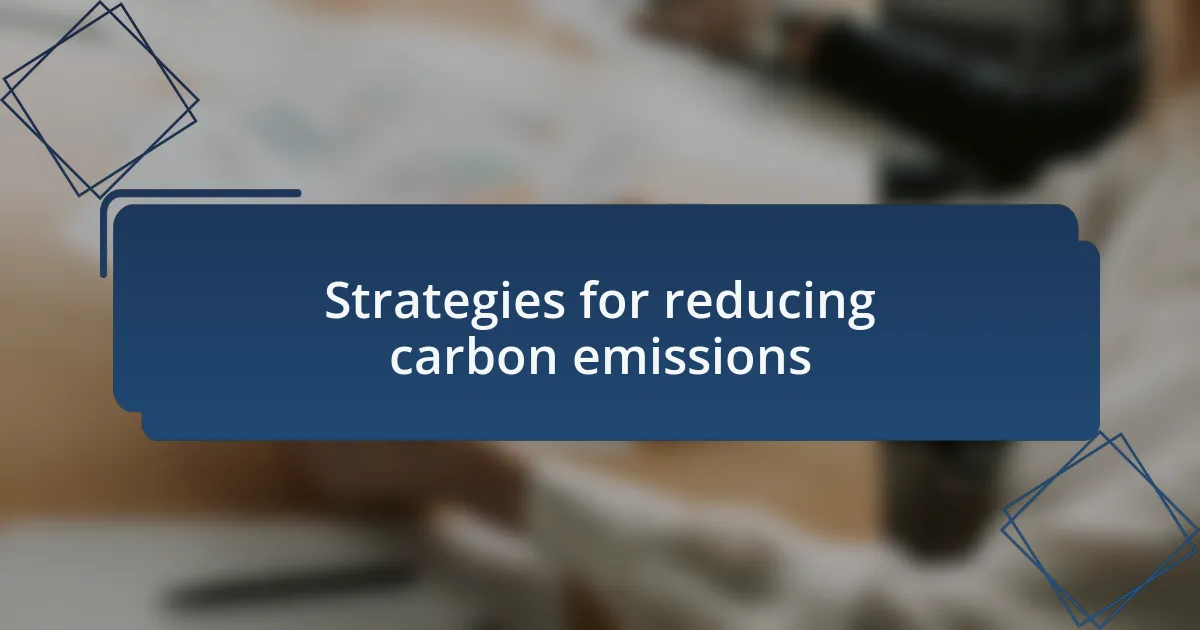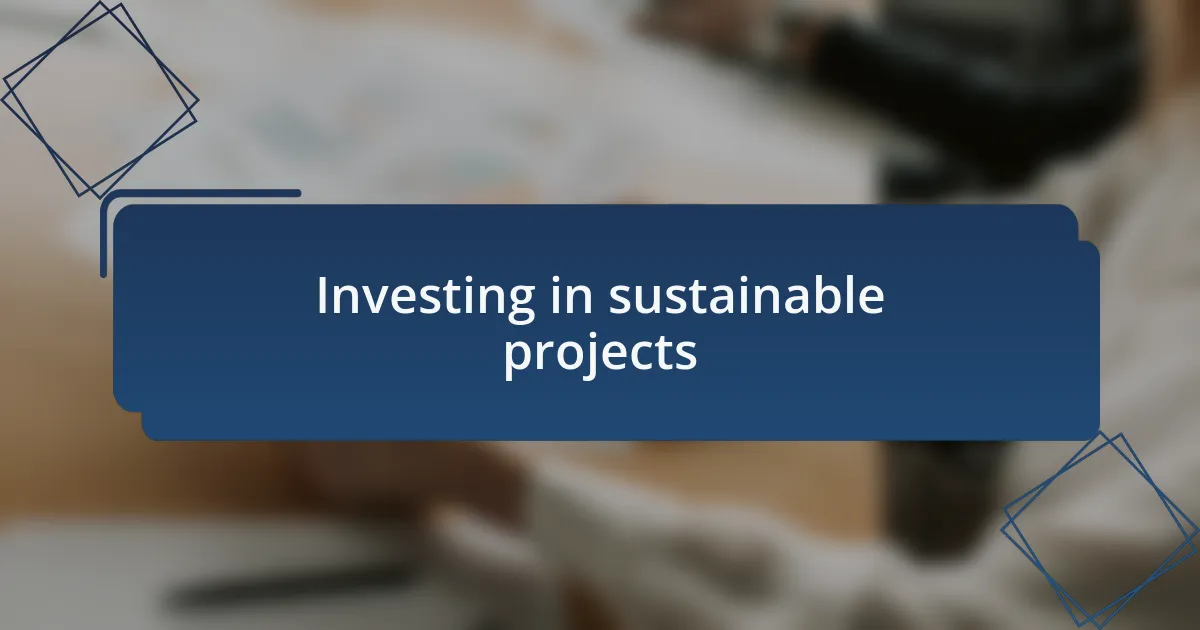Key takeaways:
- Tracking personal carbon footprints can increase awareness of individual impacts on the environment and inspire changes in habits.
- Investing in sustainable projects, such as renewable energy and green bonds, aligns financial goals with environmental values.
- Engaging in community initiatives, like tree planting, fosters a collective effort towards reducing carbon emissions.
- Eco-friendly finance encourages corporate accountability and promotes sustainable practices in businesses.

Understanding carbon emissions impact
Understanding the impact of carbon emissions is crucial in today’s world. I remember a moment while driving through a city shrouded in smog; it hit me that our everyday choices contribute to this pollution. It made me wonder, how often do we stop to think about the air we breathe and the invisible consequences of our actions?
When I started tracking my own carbon footprint, I felt a mix of empowerment and urgency. It was eye-opening to see how simple habits added up, like leaving the lights on or choosing plastic over sustainable options. Each little change we make not only reduces our own emissions but can inspire others to do the same. Have you ever considered how your choices ripple through the community?
The weight of carbon emissions extends beyond individual lifestyles; it has profound effects on our environment, health, and future generations. I’m often reminded of the stories from friends who live near industrial areas, where increased emissions have led to health issues and diminished quality of life. Don’t we owe it to ourselves and those who come after us to understand this impact better?

The importance of eco-friendly finance
Eco-friendly finance plays a pivotal role in promoting sustainable practices within our economy. Reflecting on my own experiences with eco-conscious investments, I realize how powerful it feels to support companies that prioritize the planet. Have you ever felt the satisfaction of knowing your money is working for a greener world?
In my pursuit of sustainable finance, I encountered various green initiatives that bridged economic growth with environmental responsibility. I remember attending a local workshop on ethical investing, where I learned how funding renewable energy projects could shift our dependence away from fossil fuels. It made me think: what if more people chose to invest their money in ways that fostered not just profits but also a healthier planet?
Moreover, eco-friendly finance encourages accountability in corporate behavior. Companies are increasingly aware that consumers prefer sustainable practices, leading to a race to innovate and reduce their carbon footprints. I often wonder how these shifts will shape our future; will we see more businesses embrace eco-friendly models if they recognize the financial benefits? The potential is immense, and it calls for each of us to engage in and advocate for sustainable financial choices.

Strategies for reducing carbon emissions
One effective strategy I’ve adopted is to focus on energy efficiency in my home. By replacing traditional light bulbs with LED options and using energy-efficient appliances, I’ve noticed a substantial drop in my energy bills. Have you ever tracked how small changes can lead to significant savings, both for your wallet and the environment?
Additionally, I emphasize sustainable transportation methods whenever possible. For instance, I decided to ride my bike to work instead of driving. This not only reduces my carbon emissions but also boosts my mood and keeps me physically active. Isn’t it incredible how a simple choice can enhance your quality of life while also helping the planet?
I also actively participate in community initiatives that promote tree planting and urban gardening. Last year, I joined a local group focused on reforesting a nearby area, and it felt fulfilling to contribute to restoring our ecosystem. What if everyone engaged in such grassroots movements? It could lead to a monumental shift in our collective carbon footprint, reminding us that we all have a role to play in creating a greener future.

Investing in sustainable projects
Investing in sustainable projects has been a rewarding journey for me, not just for the planet but for my financial future, too. I recall a time when I decided to invest in a solar energy startup; the excitement of contributing to clean energy solutions felt deeply satisfying. Have you ever thought how your investments could reflect your values and drive positive change in the world around us?
I’ve also explored green bonds, which allow me to support environmentally friendly projects while earning returns. Recently, I invested in a green bond that funds public transportation upgrades to electric buses in my city. Seeing the direct impact of my financial choices on reducing carbon emissions is incredibly empowering. Isn’t it reassuring to know that your money can help create a cleaner, more sustainable urban environment?
Moreover, I actively seek out companies that prioritize sustainability in their business practices. A couple of years ago, I chose to buy shares in a clothing brand committed to ethical sourcing and sustainable materials. Their dedication to minimizing waste and reducing their carbon footprint resonates with me. Isn’t it inspiring that every purchase and investment can be a vote for a healthier planet?
![]()
Tracking personal carbon footprint
Tracking my personal carbon footprint has been an eye-opening experience. I remember an afternoon spent assessing my daily habits using an online carbon calculator. Discovering how much my lifestyle choices—everything from the groceries I buy to my mode of transportation—impact carbon emissions made me rethink the little things I often overlook. Have you ever considered how your everyday actions contribute to your overall footprint?
I also keep a journal that details my energy use and waste production each week. This practice not only highlights areas where I can improve but also helps me celebrate small victories. For example, when I reduced my meat consumption, I was thrilled to see a noticeable dip in my emissions. Isn’t it fulfilling to track progress and feel like you’re actively participating in the solution?
Moreover, I’ve started sharing my findings with friends and family, sparking meaningful conversations on sustainability. I find that discussing our collective footprints pushes us all to make small yet impactful changes. Have you thought about how enlightening these dialogues could be for your community? Personal accountability, paired with shared knowledge, can create a ripple effect in our commitment to reducing carbon emissions together.

Ways to offset carbon emissions
One effective way I’ve found to offset carbon emissions is by investing in renewable energy sources, such as solar panels for my home. When I made the switch, not only did I lower my monthly utility bills, but I also felt empowered knowing I was harnessing energy from the sun rather than relying on fossil fuels. Have you ever thought about how adding renewable energy to your home could not only benefit the planet but also your bank account?
Another method I swear by is supporting local carbon offset projects. For instance, I recently contributed to a reforestation initiative in my local area, where I could actually witness the trees being planted. It was an incredible experience to see that my investment directly contributed to absorbing CO2 and improving local biodiversity. How rewarding would it be to know that your contributions are actively making a difference right in your community?
Lastly, I’ve embraced a lifestyle that prioritizes less travel. When I do travel, I make it a point to choose eco-friendly options, like train travel or carbon-neutral flights. During my last trip, not only did I enjoy the scenic routes, but I also calculated the impact of my choices and felt a sense of pride in reducing my travel footprint. Have you considered how your travel decisions can play a role in your overall carbon offset strategy?